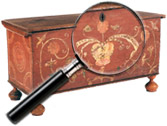Caneware, a vitreous biscuit or dry body, was first produced in 1790 and was made largely from refined local marls. It was considered an unsatisfactory body by Wedgwood and was not used commercially until about 1776. Caneware was reconstituted again after 1783 and used for tea, coffee and chocolate services, dejeuner sets and cabinet pieces. A practical use of Caneware was found in the production of game-pie dishes, simulating pastry, which remained popular through [...] Click here to continue reading.
|
|||||||
|
When A. C. Williams, Jr. bought his father’s business, the A. C. Williams Co., in 1886, it was a leading manufacturer of hardware items in Chagrin Falls, Ohio. After fires in 1889 and 1892 destroyed the Chagrin Falls operation, Williams decided to move the company to Ravenna, Ohio. It was soon after this move that a Detroit buyer suggested that the miniature product models carried by the company salesmen would make nice toys. This [...] Click here to continue reading. Westward Ho Pattern Pressed Glass A clear pressed glass with frosted relief designs comprising a pioneer’s log cabin with charging buffalo and fleeing deer in scenes of mountain and plain, Westward Ho was first produced by the Gillinder & Sons glassworks of Philadelphia in 1877. All the pattern’s pieces with a clear cover are surmounted by a frosted crouching Indian finial. Designed by the German mold-maker Jacobus for the Gillinder glassworks, Westward Ho found [...] Click here to continue reading. Rosso Antico is Wedgwood’s name for an unglazed dry-body red stoneware similar to Basalt and Caneware. Pieces other than tea sets, vases, plates, and jugs in this body are very rare, although from time to time it was used as decoration on other bodies such as Basalt and Caneware. Rosso Antico was made only sporadically because Josiah didn’t like it, as it reminded him of ‘redware’, an inexpensive body made by most of the [...] Click here to continue reading. Quezal Art Glass Named for the Central American Quetzal – a bird with brilliantly colored plumage – the Quezal Art Glass and Decorating Co. was founded in 1902 by two glassmakers, Martin Bach and Thomas Johnson, formerly working with Louis Comfort Tiffany. Their products were very similar to Tiffany’s art glass work like “Favrile” in its iridescent forms of blue, green, gold and white. Because of its quality and technical excellence the company soon [...] Click here to continue reading. Mather & Co. – Work Incentive Posters From 1923 to 1929, the Mather Company produced a series of posters which owner Charles Mather deemed “Constructive Organization Posters.” They have since come to be known as the Mather Work Incentive Posters. “Aimed at improving the work practices of employees in industry and commerce” in the boom times following the First World War, Mather combined striking, bold grpahics, direct messages and superb lithography to create “one [...] Click here to continue reading. The Fishing Schooner Bluenose The Bluenose was designed by the naval architect William Roue and built at the Smith & Rhueland Ship Yards, Lunenburg, Nova Scotia, Canada. The vessel was owned by Capt. Angus Walters and various Canadian associates from the Lunenburg area and was launched on March 27, 1921. The Colt Single Action Army Revolver This is one of the most famous guns of all time. The Army contracted and carried it thoughout the Indian Wars and it is associated with the most famous lawmen and infamous outlaws on the frontier. It was often known as the “Peacemaker”, “Frontier Six-Shooter”, and the “Equalizer”, among others. Production of this revolver began in 1872 and variations continue to be produced today. Collectors divide its history [...] Click here to continue reading. Milk Glass Battleships Many of these covered dishes were the product of condiment purveyor E. C. Flaccus Company of Wheeling, West Virginia, founded in 1877. Its leader, George A. Flaccus, was granted a design patent in 1898 for a “shipping vessel” container. As a dominant player in its market Flaccus often designed their own proprietary condiment containers and this design patent led to their classic battleship covered dishes, including those embossed Wheeling, Oregon and [...] Click here to continue reading. Confederate Currency; 1861 Montgomery Issued Notes. The 1861 Montgomery issued notes of the Confederacy are among the most desired of all American banknotes. The four denominations issued, $1000, $500, $100, and $50 (Criswell Types 1 to Type 4 respectively) combine rarity, impeccable state of the art security printing, and the optimistic sense of history that the Confederacy was to be long lived and independent to our modern era. Even though the North won the [...] Click here to continue reading. |
|||||||
|
Copyright p4A.com, ltd. & Internet Antique Gazette - 2025 - All Rights Reserved |
|||||||
